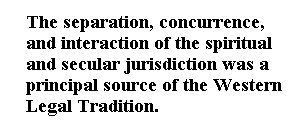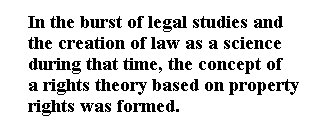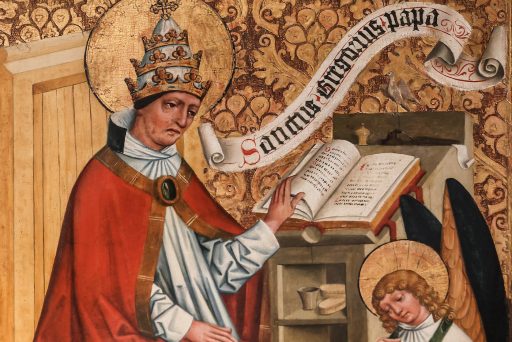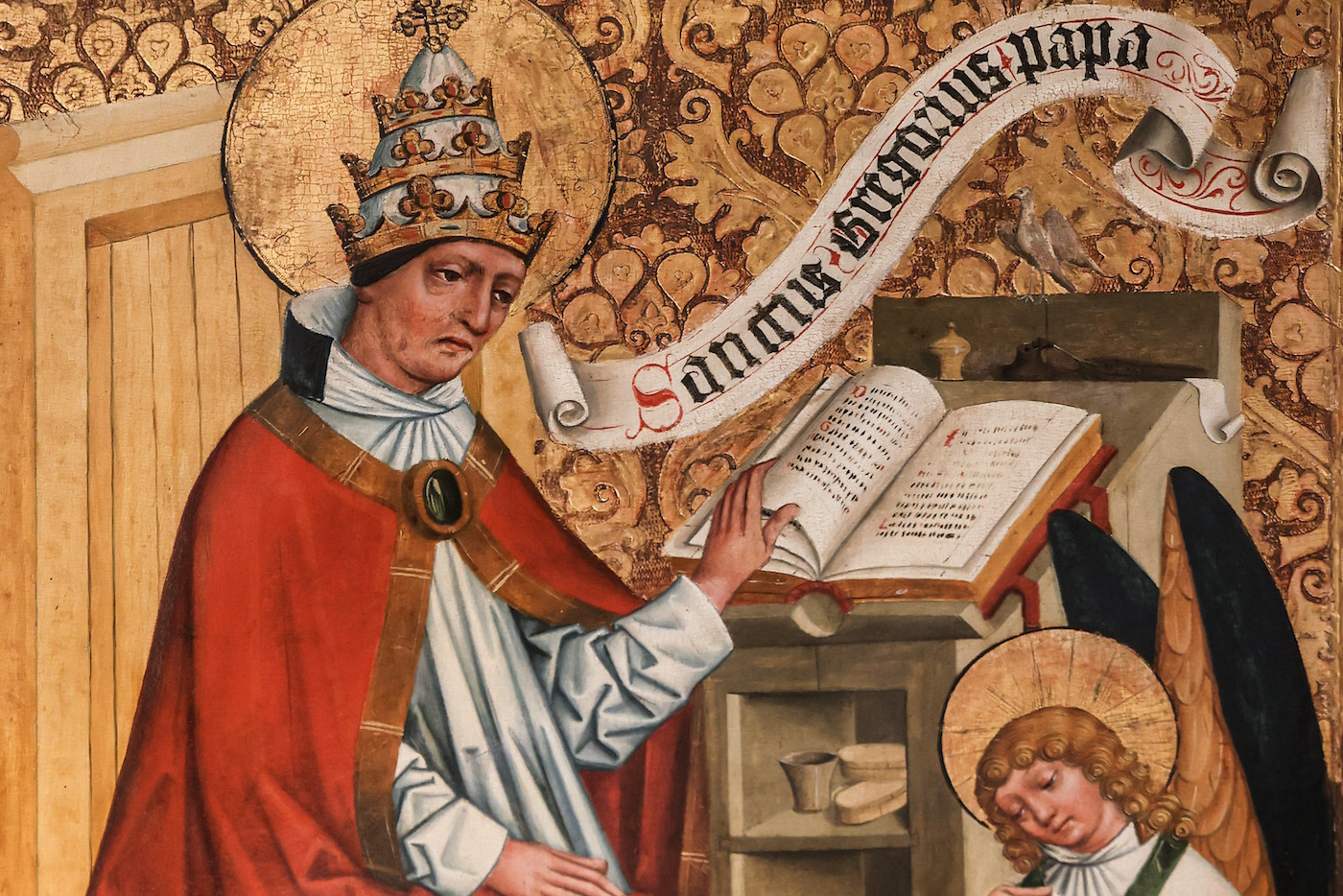Pope Gregory VII led Western Europe into great upheaval when in 1075 he wrote the Dictatus Papae (Dictates of the Pope). Pope Gregory’s Dictates, which asserted papal authority above secular authority, ignited a struggle between the Pope and Emperor Henry IV. [1] The result was the War of Investiture. Ultimately, the war led to compromise, in the Concordat of Worms in 1122. In addition to signifying the end of the War of Investiture, the Concordat signified a further separation of secular and spiritual authorities. In the ensuing years, “the separation, concurrence, and interaction of the spiritual and secular jurisdictions was a principal source of the Western Legal Tradition,”  [2] as the two jurisdictions sought to define the extent of their powers. This time of great uncertainty, and the existence of a universal consensus that the Word of God was supreme, led to the development of the Western Legal Tradition (WLT). This article will briefly survey the impact of the Gregorian Reform in the following areas of the WLT: 1) separation of power; 2) humility and accountability; 3) logic; 4) inalienable rights.
[2] as the two jurisdictions sought to define the extent of their powers. This time of great uncertainty, and the existence of a universal consensus that the Word of God was supreme, led to the development of the Western Legal Tradition (WLT). This article will briefly survey the impact of the Gregorian Reform in the following areas of the WLT: 1) separation of power; 2) humility and accountability; 3) logic; 4) inalienable rights.
Separation of Power
The Gregorian Reform resulted in the separation of power: 1) between the Church and the State; 2) within the Church; 3) within the legal systems of both the Church and the State. The severing of Church and State can be seen in the developing legal systems of both realms. In the wake of the Gregorian Reform, a new system of canon law and new secular legal systems arose. Pluralism and dualism also increased, both within and between secular and ecclesiastical systems. [3]
Separation of power also entered the Church’s legal system. Although supreme governance was given to the Pope, this did not mean that he had unlimited power. The electoral principle, the necessity to accommodate the cardinals, bishops, and clergy, and the complexity of the ecclesiastical system all constituted substantial limitations on the Pope. The Pope had to work through lower officials at the regional and local levels, [4] and these lower officials, such as bishops, also were limited by lower officials. [5] Although “these limitations certainly fell short of the modern concepts of separation of powers and of federalism; yet they constituted important checks on absolutism and at the very least fostered habits and traditions of government that popes were, for the most part, reluctant to abuse.” [6] Furthermore, the State served as a limitation against absolute power. “Constitutionalism in ecclesiastical government was facilitated above all by the limitation upon the scope of ecclesiastical authority itself. These limitations were imposed in part by the theory of dualism of ecclesiastical and secular authorities and in part by the practice of resistance by the secular authority to ecclesiastical abuses and excesses.” [7]
Humility and Accountability
This era was dominated by a universal recognition that the Word of God was supreme.  This does not imply that the participants were perfect; they simply acknowledged a common authority. The adherence to natural law–God’s law–was an important principle, and “the theory that customs must yield to natural law was one of the greatest achievements of the canonists.” Furthermore, “the subordination of positive law to natural law was reinforced by the dualism of secular and ecclesiastical law as well as by the coexistence of conflicting secular authorities.” [8] The Church’s laws were also to be measured according to their agreement with natural law. [9]
This does not imply that the participants were perfect; they simply acknowledged a common authority. The adherence to natural law–God’s law–was an important principle, and “the theory that customs must yield to natural law was one of the greatest achievements of the canonists.” Furthermore, “the subordination of positive law to natural law was reinforced by the dualism of secular and ecclesiastical law as well as by the coexistence of conflicting secular authorities.” [8] The Church’s laws were also to be measured according to their agreement with natural law. [9]
Logic
The Gregorian Reform witnessed an explosion of learning and science. It was during this time that the first universities were instituted, Latin as a scholarly language was modernized, and vernacular languages and literature began to take their modern form. [10] The scholastic method was also developed during this time. “The scholastic method presupposes the absolute authority of certain books, which are to be comprehended as containing an integrated and complete body of doctrine, but paradoxically, it also presupposes that there may be both gaps and contradictions within the text: and it sets as its main task the summation of the text, the closing of gaps within in it, and the resolution of contradictions.” The scholastic method aided both Western jurists and theologians, for both approached their respective fields as scientists. [11]
Perhaps the scholastic method was not fool-proof, but it did allow Western jurists the freedom to touch, analyze, scrutinize and challenge traditional beliefs. These jurists had “the courage to draw audacious analogies, to handle far-flung principles of equity, and to fill the lacunae of the law by intuition and imagination.” [12]
“In the period between the end of the Eleventh Century and the end of the Twelfth, a decisive turning-point was reached in the West. It was a time characterized by several transitions. There was first, the transition from a predominantly essential and exemplars outlook to a naturalistic one, an interest in existence. Secondly, there was the transition “from a symbol to dialectic,” or, as one might say with greater precision, from a synthetic perception to an inclination for analysis and ‘questions.’ Here we have the beginning of Scholasticism, to which so many scholars have devoted their talents.” [13]
The ability to question custom, tradition, and laws, and the ability to test the applicability of such principles is vital for the preservation of liberty. If dogma cannot be questioned, and improved, then man’s liberty is at stake.
Inalienable Rights
The connection between the Gregorian Reform and the development of a rights theory is the discovery and interpretation of Justinian’s Digest. In the burst of legal studies and the creation of law as a science during that time, [14] the concept of a rights theory based on property rights was formed.  Tuck writes that “it is among the men who discovered the Digest and created the medieval science of Roman law in the twelfth century that we must look to find the first modern rights, theory.” [15] Tuck further suggests that “Ecclesiastical law was of course greatly concerned with general questions of welfare: in the Church, Europe had an institution unprecedented in the Roman world in that it was actually designed (at least in part) for charitable purposes. It is not surprising that a theory about rights as claims should have evolved from within an institution which was so concerned with the claims made on other men by the needy or deserving.” [16] Pope Gregory VII was probably more concerned with the power of the Church than with inalienable rights when he wrote the Dictates. But his efforts nevertheless led to the development of a profound theory of inalienable rights.
Tuck writes that “it is among the men who discovered the Digest and created the medieval science of Roman law in the twelfth century that we must look to find the first modern rights, theory.” [15] Tuck further suggests that “Ecclesiastical law was of course greatly concerned with general questions of welfare: in the Church, Europe had an institution unprecedented in the Roman world in that it was actually designed (at least in part) for charitable purposes. It is not surprising that a theory about rights as claims should have evolved from within an institution which was so concerned with the claims made on other men by the needy or deserving.” [16] Pope Gregory VII was probably more concerned with the power of the Church than with inalienable rights when he wrote the Dictates. But his efforts nevertheless led to the development of a profound theory of inalienable rights.
Conclusion
It would be unwise to characterize the Gregorian Reform, and the people involved, as absolutely good. On the contrary, it is probably safe to say that at least some of the people involved were selfishly motivated. But history demonstrates that this movement tended to draw mankind and society away from the scourge of tyranny rather than to it. Tyranny is the selfish use of power that often results in the violation and exploitation of other people. Liberty, on the other hand, is the humble use of power, according to God-given standards, that protects and enhances the inalienable rights of others. No man is perfect, and neither is any movement engineered by man. But so far as the Gregorian Reform served to draw man closer to liberty and further away from tyranny, it deserves further study and recognition.
- Harold J. Berman, Law and Revolution: The Formation of the Western Legal Tradition (Canbridge: Harvard University Press, 1983), 95.
- Ibid., 99.
- Ibid., 116-118.
- Ibid., 207-209.
- Ibid., 212.
- Ibid., 213.
- Ibid.
- Ibid., 145.
- Ibid. 146-147.
- Ibid., 103.
- Ibid., 131.
- Ibid., 149.
- Yves Congar, O., After Nine Hundred Years (New York: Fordham University Press, 1959), 39.
- Berman, 121-122.
- Richard Tuck, Natural Rights Theories: Their Origin and Development (Cambridge: Cambridge University Press, 1979), 13.
- Ibid., 15.





